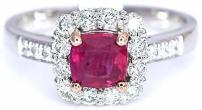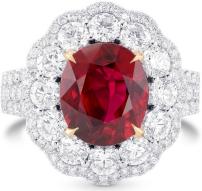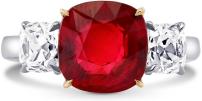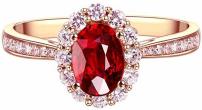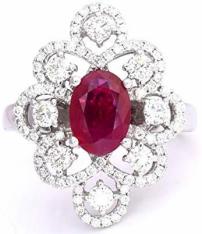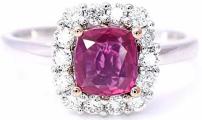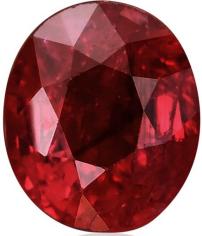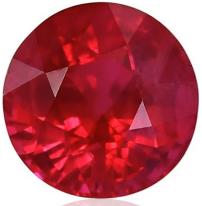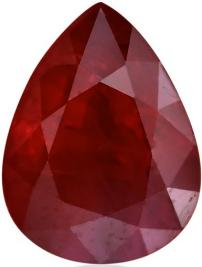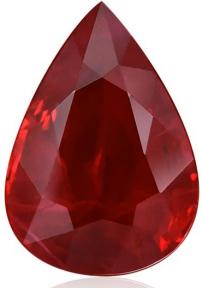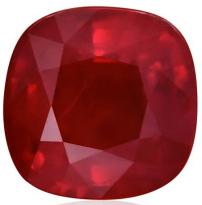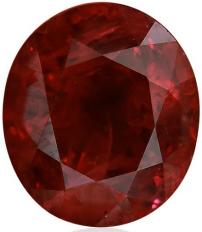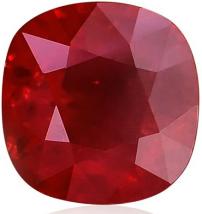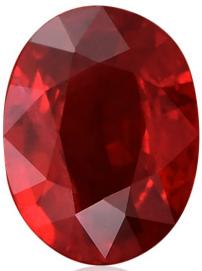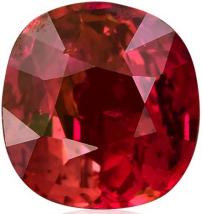Pigeons Blood Ruby Color is the most coveted color grade for gemstone ruby. Blood is a frequently used symbol to represent the color of ruby. The gem is likened to the blood in the right-ventricle or the first two drops of blood from a freshly slaughtered pigeon. Traditionally, the term ‘pigeon’s blood’ describes the red to slightly purplish or pinkish red color of rubies.
Click On The Images
Color has the most profound influence on the value of ruby. The finest specimens flaunt a pure vibrant red to slightly purplish-red color. Pronounced secondary hues of orange or purple lower the quality & value while finest rubies exhibit vivid color saturation.
In a related development, buyers are ever more demanding quality certificates from reputed gemological institutes while buying expensive stones. In such a scenario, labs are lobbied to validate a ruby’s color to be the most desirable. As such, there is a plethora of reports declaring the hue to be pigeon blood red.
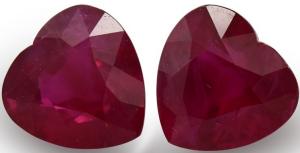 |
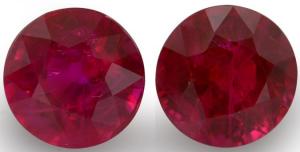 |
|
| 4.34 carat, Pigeons Blood Ruby Color, Burmese Ruby, Heart Shape, GRS | 4.04 carat, Pigeons Blood Ruby Color, Burmese Ruby, Round Shape, GRS |
Click On The Images
The trend marks a repeat of an earlier unholy rush for lab certificates that occurred in 1979. At the time American Gemological Laboratories established the foremost colored gemstones grading reports. According to this nomenclature, there existed a numerical color rating scale ranging from 1.0 to 10.0.
Click On The Images
Exceptionally high-quality rubies scored 3.5 on that scale of quality. The dilemma was a difference in perception for the ideal red in rubies. Labs preferred ‘purity of red’. Gems holding the highest levels of primary red were awarded higher color grades than gemstones with desirable secondary hues of pink or orange. There was lack of understanding among gem dealers about color terminology applied by color scientists. The methodology conflicted with traditional concept of ideal ruby color.
Click On The Images
Soon, buyers realised this blooper. And prices of gemstones holding the so called ideal color rating went into a free fall. In certain cases, value fell as much as 90% causing immense loss to buyers who relied on certificates while buying.
Soon, buyers realised this blooper. And prices of gemstones holding the so called ideal color rating went into a free fall. In certain cases, value fell as much as 90% causing immense loss to buyers who relied on certificates while buying.
Click On The Images
Could history repeat itself with a growing number of rubies acquiring the highly coveted ‘pigeon’s blood red’ color grade. Then again, reputed gemmologists claim to be lucky even to have come across less than 25 rubies deserving to be called pigeon’s blood red during a lifetime of work covering several decades.
Click On The Images
Now an unreal number of people own rubies certified as pigeon’s blood red. And the certificates are from reputed gemological labs including GIA. There is simply no way so many stones could deserve this designation.
The trend was started by GRS Lab in 1998. It expanded the eligibility criteria for a ruby to be designated as Pigeons Blood Ruby Color. A stone could acquire this coveted color grade notwithstanding its place of origin. Earlier, this grade was reserved for material originating from Burma’s legendary Mogok tract only. Now gemstones from new mining areas such as Mozambique too started achieving the highest color grade.
Other labs followed suit and suddenly everyone started demanding pigeon’s blood grade on gemological reports for gemstone ruby. The phrase ‘pigeon’s blood red instantaneously became a singular synonym for supreme ruby color. So much so that quality rubies started failing to sell without this grade on certificate. This confers new-fangled power to the labs issuing them.
Buyers are being exposed to an element of risk. And it does not seem possible to convert a subjective term like pigeon’s blood into an objective rating. The seven members of the international Lab Manual Harmonization Committee including the GIA, the Swiss Gemological Institute (SSEF) and the Gubelin Gem Lab need to sit together and arrive at some sort of standardization of the term like they have done for Paraiba Tourmaline & Padparadscha Sapphire.
Individually, the labs have already adopted their own standards. And they differ greatly. SSEF & Gunelin acknowledge the time honored tradition and grant pigeons blood ruby color grade only to untreated gemstones from Burma. GRS grants this grade based merely on color regardless of region of origin. GIA too, is generous in bestowing this grade, but restricts its mention in the comments section of the report only. Here it concedes that the stone’s color corresponds to the color represented by the term ‘pigeon’s blood’ as understood in the jewelry world.
A global understanding needs to be arrived between gemological labs and merchant groups to arrive at an objective grading system for rubies. The system should be efficient & internationally recognized. It should satisfy both the traders and the buyers. For example, the time honored system of awarding Pigeons Blood Ruby Color grade to top color and quality ruby gemstones from Burma may be universally accepted. The stones will also meet specific quality standards based on mutual agreement. Any type of treatments could be completely prohibited or restricted to barest minimum.
Designated color grades should be consistently measurable using standard instruments. They should by framed into strict legal designations enforceable by law all over the world. Gemologists & connoisseurs should be able to recognize and identify the rarity of fine gems as well as their origins from specific localities.
The benefits of such a system cannot be overstated. It will boost customer confidence and lead to increasing sales. A lot of time can be saved and heart-burn avoided by adopting a standardized language for describing the appearance of colored gems.
See More Gemstones As Follows
